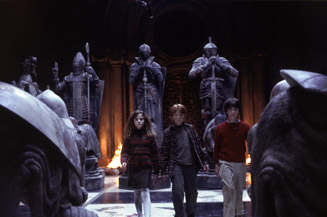Are You With Us?
Harry Potter and the Sorcerer's Stone
By Ryan Mazie
December 10, 2012
BoxOfficeProphets.com

I was most surprised to see how young the actors were. Daniel Radcliffe, Rupert Grint, and Emma Watson were plucky children, certainly not the refined young adults we see covering magazines today.
A pop culture phenomenon that even those living under rocks have heard about, Harry Potter and the Sorcerer’s Stone is our introduction to the young wizards attending Hogwarts School of Witchcraft and Wizardry, focusing on the titular boy with the circular glasses and lightning bolt scar given to him after surviving a deadly curse by “He Who Must Not Be Named.”
While the world of Hogwarts is now commonplace to see on film, I am sure it must have been magical when I was nine-years-old, sitting in the theater, seeing the world that I had read about come to life. The first Quidditch match. The first spell cast. The first look at Hogwarts. I was just as spellbound by Potter’s onscreen adventures as his written ones.
Unlike the more mature films that started on later in the series evolution, Sorcerer’s Stone is steeped in imaginative color layouts. The film focuses heavily on CGI, with director Chris Columbus taking time to showcase the different aspects of the castle, from talking paintings to moving staircases. The graphics take a co-starring role, being placed front and center rather than being a natural part of the magical world. While not a criticism, it is also not a compliment but rather a comment on the times. Still one month away from The Lord of the Rings: The Fellowship of the Ring being released, the intense CGI, which still holds up quite well today, was a spectacle that could have been a driving factor alone outside the name brand factor.
Screenwriter Steve Kloves (who has a screenwriter credit on all of the Potter films except The Order of the Phoenix) adapts the film with the utmost faithfulness to the book (or as similar one can get turning the page to screen), He says that he collaborated with author J.K. Rowling to get even minor details correct (and to not contradict the upcoming books, given that when the first film was released, only four out of the seven books were published).
Director Christopher Columbus and Warner Bros. also respected Rowling’s written word, agreeing to her terms of casting an all-British cast.
Radcliffe shines as the Boy Who Lived, winning over audiences for eight films straight, growing as an actor right in front of our eyes. It’s a risky proposition to sign children for an iconic role that will require them to film in front of cameras for a decade (and then be remember for the part for near eternity). The casting directors worked magic of their own, having all of the major and supporting actors stick to their roles throughout the franchise (with the exception of Richard Harris, who died just before the premiere of Chamber of Secrets and was replaced in the third film by Michael Gambon for the remainder of the series).
Still recouping from their time on the Potter set, it will be interesting to see what the children-turned-adults will now do with their acting careers after such a great launching pad. Radcliffe showed promise in having a post-Potter career with the period horror The Woman in Black, while also taking some time off screen for the Broadway stage. Emma Watson went the indie route with My Week with Marilyn and The Perks of Being a Wallflower. Rupert Grint has so far laid low after last summer’s final chapter of the series being released, although he has a lengthy list of upcoming features according to his IMDb page. Director Columbus flopped with his screen adaptation of Rent and couldn’t get the Potter magic to strike twice with the Greek God-based child fantasy franchise hopeful Percy Jackson.
What I find most surprising about the Potter franchise is how the films kept improving upon themselves, rather than regressing - and Sorcerer’s Stone set the bar fairly high, ranking in at 79% on Rotten Tomatoes. While not as dramatic as the latter films, Stone was the perfect set-up to get audiences as eager to buy tickets to the next movie as Rowling had readers ready to purchase a copy of the newest book. However, unlike The Lord of the Rings franchise, the Academy Awards have unrightfully given the cold shoulder to this series. It has not been nominated for anything beyond technical categories and never won any of its nominations.
Released the weekend before Thanksgiving in 2001, Harry Potter immediately broke box office records, having the highest opening day, single day, and opening weekend gross ever at the time (all of which have now been surpassed). Against a $125 million production budget (plus a very costly marketing budget), the film opened to $90.3 million ($126.7 million adjusted) over the first weekend. It wrapped up with $317.6 million ($445.5 million today) and found a significant chunk of change from overseas to the astronomical tune of $657.2 million. The film holds the second-highest gross for the series, being surpassed by the last entry of the series (Deathly Hallows Part 2).
It will be interesting to see if this weekend’s The Hobbit will find success akin to Harry Potter by having the ability to create a new audience a decade later or perform like a sequel to the Lord of the Rings franchise.
Technically not a perfect film, I can still see the beginning magic within Harry Potter and the Sorcerer’s Stone that seven films later turned into something spellbinding. At a challenging two hours and 33 minutes for its younger audience members, Sorcerer’s Stone is filled to the brim with the most basic of childhood emotions such as amazement, fear, excitement, and laughter. But boredom is certainly one never found.
Verdict: With Us
8 out of 10